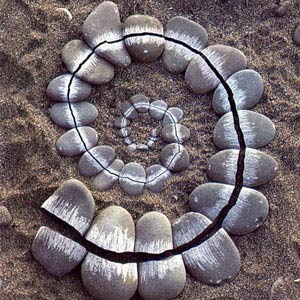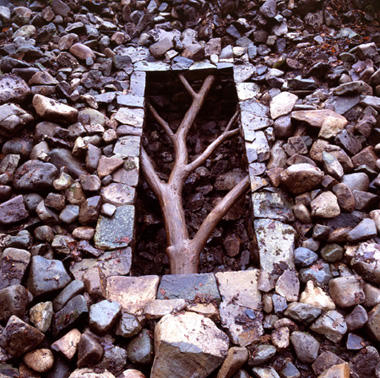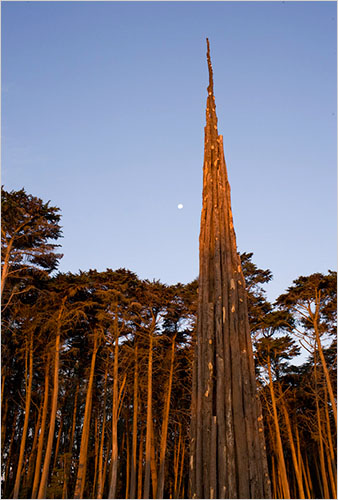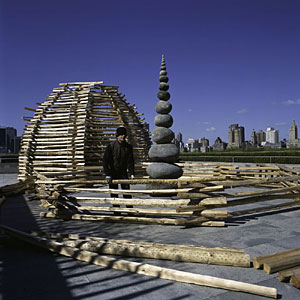Naturalist Art Keeps Its Plants On
A collaboration with nature resulting in sculptures with an ecological art narrative. Call it coaxing nature and romancing the stone. Andy Goldsworthy uses nature as his canvas and creates arrangements and composition with materials generally found on the work’s site. Nothing is created per se, he simply shapes elements of the environment into an aesthetic form that is natural, but to which the viewer is not pre-disposed to recognize.This type of work is usually termed land art, earth art, earthworks or naturalist art began in the 1960′s and was based on the increasing ecological sensibility. Goldsworthy regards all his creations as transient, or ephemeral. He photographs each piece right after he makes it. His goal is to understand nature by directly participating in nature as intimately as he can. He generally works with whatever comes to hand: twigs, leaves, stones, snow and ice, reeds and thorns.
In a sense its a very primitive form of art that involves a skill set almost unique to Goldsworthy. Hole cutting, cracking, the materials and the conceptual development seem new yet may have antecedents in older civilizations relationship with the spirit world ,and his ferreting out of new archetypes based on nature does recalls anthropological and archaeology as well. Though the temporality of the pieces, or the expectations on durability and visibility are reminiscent of graffiti and pavement artists such as Julian Beever.
His success, and critical acknowledgement has resulted in more museum style exhibitions for a mass audience. The nature of Goldsworthy’s work, does not necessarily translate to full advantage in captivity, for want of a better description. One exhibition in San Diego, was less than affirmative. David Lewinson on the Three Cairns exhibition:
”What this exhibition makes clear is that the best of Goldsworthy’s art is conveyed to its public far more successfully through journals and books than through museum exhibitions. In this context, the vitality and intimacy of his art are all but lost.Goldsworthy bears much of the responsibility for this because he seems to have paid almost no attention to where he was. Such, at least, is the impression created by the show in San Diego. ”( David Lewinson )
” But here in America, where we romanticize nature as an escape from our civilized selves, Goldsworthy is revered as a figure of Thoreau-like purity, and lately he has been inundated with requests…. Goldsworthy basically embraces the traditional goal of art — that is, he wants to add interesting objects to the world. His sculptures are consistently well crafted, richly colored and visually striking. He favors curvy lines and geometric shapes, particularly circles, and in a typical sculpture he might stack driftwood or icicles he collected in the woods into a perfectly balanced dome that stands taller than he does and has the formal complexity of museum-quality abstract art. Even his most casual pieces are composed in a superorderly way, and they hark back to the smooth forms of a modernist like Brancusi, whom Goldsworthy describes as one of his heroes”.( Deborah Solomon, New York Times)
There is much experimentation with various natural materiel such as leaves, grasses, stones, wood, sand, clay, ice, and snow. Given, the enormity of the raw materials it could stated his work is highly materialistic and a reflection of materialism in general. The seasons and weather determine the materials and the subject matter of his projects. With no preconceived ideas about what he will create, Goldsworthy relies on what nature will give him. Goldsworthy “feels” the energy from nature and transcends that energy into an art form. His transient sculptures contradict the permanence of art in its historical pretense.
Goldsworthy’s approach is to interrupt, shape, or in some other way temporarily alter or work with nature to produce his fragile, mutable pieces.As with most of his works, ultimately, the materials used to create this piece returned to their natural state, leaving no trace of the artwork’s existence save for the photos and DVD’s.
“Movement, change, light, growth and decay are the lifeblood of nature, the energies that I try to tap through my work. I need the shock of touch, the resistance of place, materials and weather, the earth as my source. Nature is in a state of change and that change is the key to understanding. I want my art to be sensitive and alert to changes in material, season and weather. Each work grows, stays, decays. Process and decay are implicit. Transience in my work reflects what I find in nature.”
”Stone Houses,” as the Met project is titled,( Metropolitan Museum of Art ) integrates the boulders from Scotland into the wilds of Manhattan. At first glance, the piece consists of two monumental wooden domes that stand 18 feet high and seem both familiar and alien. Constructed by hand from split-rail fencing that originated in Maine, the domes can variously make you think of a mosque, a log cabin or a cozy forest hut built by a hobbit who forgot to include a front door. Although you can’t enter them, you can peer between their slats at the stacked columns of stones within. Deborah Solomon N.Y. Times )
Usually we gaze out at a landscape. But in this case we gaze inward, into the quietly romantic domes. It’s the reverse of Central Park, another assembly of wood and stones, and the sprawling backdrop for the piece. In the end, ”Stone Houses” allows you to look at once at a city landscape and a rural landscape, and to feel the affinities between them. I asked Goldsworthy to define the word ”landscape,” and he replied, a bit cryptically: ”A landscape does not have to involve land. Time is a landscape.” (Deborah Solomon, N.Y.Times)


